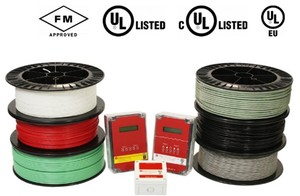

|
Brian Sims
Editor |
| Home> | Fire | >Alarms and Detection | >Photovoltaic Systems: Enhancing Fire Safety |
Photovoltaic Systems: Enhancing Fire Safety
16 April 2025
PHOTOVOLTAIC (PV) SYSTEMS harness sunlight to generate electricity through semiconductor materials, providing a sustainable and renewable energy source. Being electrical systems, though, means that solar PV installations present common fire risks that need to be managed to ensure safety and performance, as Spike Armstrong discovers.

Installed on rooftops, integrated into building structures or otherwise set up in ground-mounted configurations, solar panels optimise sunlight capture, while also lowering energy costs for commercial and industrial properties.
Common fire risks with these installations include electrical fires, the potential for overheating, combustible roof materials, poor installation and battery storage. Let’s take a look at each in turn.
In terms of the potential for electrical fires, faulty wiring, loose connections and degraded components can cause short circuits, sparking electrical fires within the system. When it comes to overheating, dust accumulation, the presence of debris or shading on solar panels can create localised ‘hotspots’, significantly increasing the risk of overheating and fire.
Roofing materials like wood or certain types of insulation can contribute towards the rapid spread of fire if ignited, while sub-standard mounting, inadequate clearances and incorrect wiring used during installation may create serious fire hazards, compromising system safety.
Finally, systems with integrated battery storage introduce additional risks, including the prospect of thermal runaway and electrolyte leakage.
Challenges in fire detection
Large-scale rooftop installations can make routine inspection and maintenance of fire detection systems more challenging. The presence of solar panels, wiring and mounting structures often obstructs traditional fire detectors, such as smoke or heat sensors, in turn limiting their effectiveness.
Fire detectors in solar PV installations may experience reduced sensitivity due to temperature fluctuations, humidity and the build-up of dust and debris. Effective fire safety requires detectors that are designed to resist environmental factors and maintain reliable performance.
Retrofitting solar PV systems with fire detection solutions requires seamless integration with building systems, such as HVAC, and must ensure easy access for reliable and routine maintenance.
Linear Heat Detection
Thermocable’s ProReact Linear Heat Detection (LHD) solution can protect solar PV installations, providing continuous, reliable and early detection of fire hazards. Unlike spot detectors, LHD senses heat along its entire length, ensuring comprehensive coverage of irregular roof layouts.
Prompt alerts enable swift responses, thereby reducing potential damage. Withstanding UV exposure, temperature extremes and debris accumulation, Thermocable LHD ensures long-term reliability.
The system can be configured flexibly to suit various rooftop arrangements, minimising installation complexity and maintenance requirements. Compatible with UL, FM and EN standards, Thermocable is able to integrate seamlessly with existing fire safety systems.
In operation, ProReact LHD uses a heat-sensitive cable that detects temperature changes along its entire length. When the temperature surpasses a set threshold, the cable’s electrical properties change, triggering an alarm through a connected fire control panel. This continuous monitoring minimises undetected fires and can facilitate precise and targeted fire suppression.
Planning, design and installation
It’s best to select cable and mounting brackets based on the installation environment, ensuring that the alarm temperature is 20°C higher than the maximum expected ambient temperature.
Route the LHD cables directly at the point of risk, on top of the roof cover and beneath solar PV panels, to ensure effective early detection and comprehensive coverage.
Integrate LHD seamlessly with the overall fire alarm system to enable centralised monitoring and streamlined response capabilities.
Compliance and recommendations
Insurance providers, including FM Global, advocate the use of LHD in solar PV installations. FM Global’s ‘Property Loss Prevention Data Sheet’ (entitled DS 1-15 Roof-Mounted Solar Photovoltaic Panels) specifically recommends “the installation of FM Approved linear heat detection on top of the roof cover and below the PV modules, ensuring comprehensive fire safety protection.
Implementing Thermocable ProReact LHD is a key measure for improving fire safety in solar PV installations. By understanding the unique risks inherent in solar PV systems and integrating this solution, the likelihood of fire incidents can be significantly reduced.
Thermocable ProReact LHD provides a reliable and proactive approach to early fire detection, enhancing the overall protection of solar PV assets. This technology not only enables rapid detection of potential hazards, but also aligns with industry Best Practice and what are now increasingly stringent insurance-driven project specifications.
Spike Armstrong is Sales Manager at Thermocable (www.thermocable.com)- Protecting our past
- Patol aspirating systems protecting your food
- From the editor
- Fire safety returns home to NEC Birmingham
- Building hope
- Blog for FSM website
- Advanced protects National Theatre
- Fire Safety Event 2017 - Live Coverage
- Advances in false-alarm management
- C-TEC rolling out CPD training events












